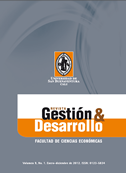La Revista Gestión & Desarrollo proporciona acceso abierto e inmediato a su contenido, basada en el principio de ofrecer al público un acceso libre a las investigaciones para ayuda a un mayor intercambio global de conocimiento.
Excepto que se establezca de otra forma, el contenido de esta revista cuenta con una licencia Creative Commons Attribution-NonCommercial-NoDerivatives 4.0 International (CC BY-NC-ND 4.0) que puede consultar en http://creativecommons.org/licenses/by-nc-nd/4.0/
- Attribution — You must give appropriate credit, provide a link to the license, and indicate if changes were made. You may do so in any reasonable manner, but not in any way that suggests the licensor endorses you or your use.
- NonCommercial — You may not use the material for commercial purposes.
- NoDerivatives — If you remix, transform, or build upon the material, you may not distribute the modified material.
- No additional restrictions — You may not apply legal terms or technological measures that legally restrict others from doing anything the license permits.
Abstract
Today, organizations are concerned about competitiveness, given its importance in productivity increasing and costs reducing. Porter (1991) stated that the conditions of demand, competition, strategies, business structures, industry competitiveness and supporting industries, coordinated among themselves, encourage the creation of a cluster of companies that are subcontracted and services that support them. This article is the result of a research carried out in the metal-mechanic sector –spare parts subsector- in the municipalities of Cali and Yumbo, in which the opportunity of developing a cluster around the development of collaborative projects between companies is evident, establishing entrepreneurs training programs in innovation and marketing. This allows them to enter to the world of global competitiveness and to contribute to the productive improving of different regions. On the other hand, associated to competitiveness is the specialization of tasks to improve the productivity of regions. This is increased through the companies’ organizational incentive and technological innovation, mechanisms to leverage the shared knowledge of entrepreneurs. The aforementioned evidences that innovation is a competitive factor that facilitates the implementation of a cluster in the region.
Keywords:
References
– Universidad EAN. Facultad de Ingeniería (2012). Diagnóstico para empresas del sector metalmecánico, utilizando la técnica MICT para capacidad tecnológica. Recuperado de: http://repository.ean.edu.co/.
– Foro Económico Mundial. (2012). Reporte global de competitividad del foro económico mundial 2011-2012. Resultados para Colombia 2011. Dirección de desarrollo empresarial DNP. Recuperado de: https://www.dnp.gov.co/LinkClick.aspx?fileticket=H9iow2IHK7g%3D&tabid=1284
– MONTERO, C. y MORRIS, P. (2011). Territorio, competitividad sistémica y desarrollo endógeno. Metodología para el estudio de los sistemas regionales de innovación. Recuperado de: http://razonpublica.com/index.php/economy-sociedad-temas-competitividad-colombiava-perdiendo-el-ano.html
– MURCIA, C. P. (2013). “Factores de innovación que inciden en la competitividad del subsector reparación de maquinaria y repuestos en los municipios de Cali y Yumbo”. En: Revista Libre Empresa, No. 18, pp. 111-124.
– PORTER, M. (1991). La ventaja competitiva de las naciones. Barcelona: Plaza & Janes.
– __________. (2004). Estrategia competitiva. Técnicas para el análisis de los sectores industriales y de la competencia. México: Compañía Editorial Continental.
– PRADA, R. (2011). “La matriz estratégica jerárquica”. En: Harvard Business Review. Septiembre de 2011.
– __________. (2013). Gestión de la innovación y la creatividad sinecmática. Amazon, ASIN: B00B91R9W6.









